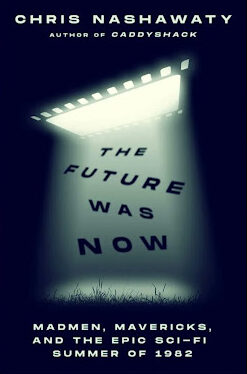By CHRIS NASHAWATY (Flatiron Books; 2024)
If you’re a film buff this book is a must read. The subject is mainstream science fiction cinema in the summer of 1982, a pivotal time for those of us who lived through it (I was in single digits back then but recall the period, and its film releases, quite vividly).
The eight films covered in THE FUTURE WAS NOW include E.T. THE EXTRA-TERRESTRIAL, BLADE RUNNER, THE THING, STAR TREK II: THE WRATH OF KHAN, THE ROAD WARRIOR, TRON and—stretching the boundaries of sci-fi a bit—CONAN THE BARBARIAN and POLTERGEIST. All were released during an eight-week period that proved quite prophetic, ushering in the blockbuster mentality that overtook Hollywood, as well as the subject matter that tends to fuel most blockbusters. Science fiction was long considered a ghetto genre by Hollywood, but after 1982’s summer bonanza—trailing the precedent-shattering release of STAR WARS by five years—that idea was rubbished forever.
E.T. THE EXTRA-TERRESTRIAL 1982 (Trailer)
The filming of these opuses was far from smooth. E.T.’s making was pleasant enough, but the rest were beset with challenges. Budget overruns, unsurprisingly, were a common issue, as were meddling studio executives, costly special effects and, in the cases of BLADE RUNNER and THE THING, critical indifference. From a financial standpoint only E.T., STAR TREK II and POLTERGEIST were unqualified successes, with BLADE RUNNER, THE THING, TRON, THE ROAD WARRIOR and CONAN all fated to wait years, if not decades, to attain a full appreciation.
BLADE RUNNER 1982 (Trailer)
What’s especially fascinating about this account is how the fortunes of these films’ creators, who included Spielberg, Ridley Scott, John Carpenter, George Miller, Nicholas Meyer and John Milius, intersected. George Lucas was another pivotal figure, even though he wasn’t directly involved in any of 1982’s movies, as he was Spielberg’s friend and employer (on the previous year’s RAIDERS OF THE LOST ARK), and a huge inspiration to Scott—whose mega-successful ALIEN (1979), in turn, was integral to the greenlighting of Carpenter’s THE THING. Milius was a longtime friend, and sometime collaborator, of Spielberg, while Miller worked with the latter on the following year’s TWILIGHT ZONE: THE MOVIE.
STAR TREK II 1982 (Trailer)
Many of the stories related in these pages have already been told in previous books like Paul Sammon’s FUTURE NOIR: THE MAKING OF BLADE RUNNER, Michael Deeley’s BLADE RUNNERS, DEER HUNTERS AND BLOWING THE BLOODY DOORS OFF, Nicholas Meyer’s THE VIEW FROM THE BRIDGE, Joseph McBride’s STEVEN SPIELBERG: A BIOGRAPHY and Luke Buckmaster’s MILLER AND MAX. Given all that prior information, we’re faced with a problem: the “facts” presented in THE FUTURE WAS NOW, based in large part on retrospective interviews that may well be predicated on faulty memories, don’t always match up with previous accounts.
TRON 1982 (Trailer)
An example of that divergence is a description of George Lucas first learning of the success of STAR WARS while vacationing in Maui with Spielberg, which contradicts the famous story of Lucas making that realization at the Hamburger Hamlet across the street from Hollywood’s Chinese theater. There’s also a claim made by Nashawaty that Stephen King was rejected as the scripter of POLTERGEIST because of money, which goes against King’s own statement that he never received the offer because he was “on a ship going across the Atlantic.”
So this book may not be as authoritative as it purports to be. It’s a fun read nonetheless, providing a long-overdue accounting of a neglected but vital period in film history and the people involved in it.

